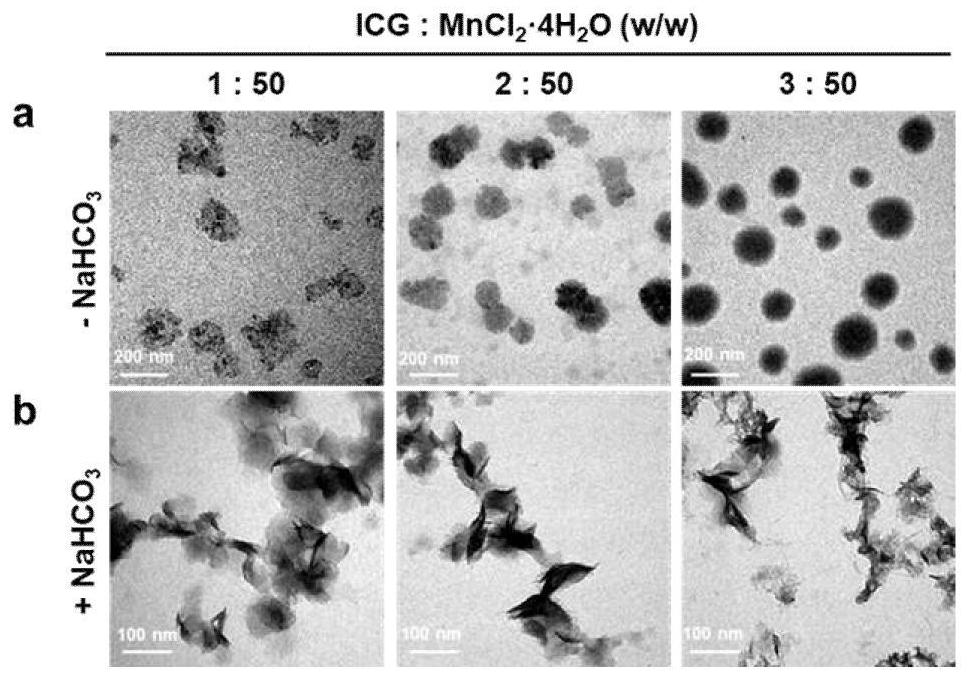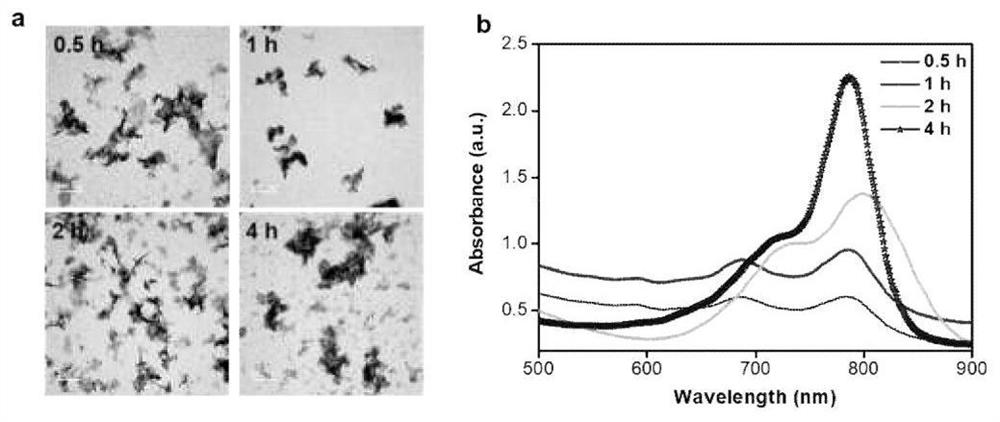A kind of preparation method and application of medical carbonate nanometer material
A technology of nanomaterials and carbonates, which is applied in the field of biomedical nanomaterials, can solve the problems that limit the development of nanomaterials, achieve the effect of inducing apoptosis and necrosis, and stimulating oxidative stress response
- Summary
- Abstract
- Description
- Claims
- Application Information
AI Technical Summary
Problems solved by technology
Method used
Image
Examples
Embodiment 1
[0073] Synthesis and characterization of embodiment 1 manganese carbonate nanoparticles
[0074] (1) Manganese chloride tetrahydrate and indocyanine green were mixed and stirred for 3 hours according to the mass ratio of 50:1-50:3;
[0075] (2) Place the material (Mn-ICG) gained in step (1) in ammonium bicarbonate (NH 3 HCO 3 ) in an environment of decomposition and diffusion, react at room temperature (30°C), and the reaction time can be controlled within 1-4h;
[0076] (3) The material obtained in step (2) is centrifuged at 5000rpm for 10min, and the precipitate is taken;
[0077] (4) ultrasonically disperse the precipitate obtained in step (3) in 20 mL of absolute ethanol, centrifuge and wash at 5000 rpm for 10 min, repeat this step 3 times, and obtain the precipitate;
[0078] (5) Disperse the precipitate obtained in step (4) in 50 mL of absolute ethanol, and add polyallylamine hydrochloride (PAH, molecular formula (C 3 h 7 N) n xHCl, the average molecular weight is ...
Embodiment 2
[0084] Example 2MnCO 3 -ICG nanomaterials for cell experiments
[0085] Taking murine breast cancer 4T1 cells as a research model, the MnCO prepared in Example 1 was further explored. 3 - Research on ICG nanomaterials for combination therapy of tumors. At the same time, human malignant glioma U87MG cells and human liver cancer HepG2 cells were used to verify MnCO 3 -Therapeutic effect of ICG nanomaterials on tumor cells.
[0086] (1) Cell uptake test
[0087] Seed 4T1 cells on glass bottom cell culture dish (confocal dish) Medium (10 5 cells), cultured for 24h, after the cells adhered to the wall, mixed with MnCO 3 -ICG medium ([Mn]: 5μg / mL) was co-incubated for different times (2, 4, 8, 12 and 24h), washed three times with PBS, stained with Hoechst33342 (5μg / mL) for nuclei, washed three times, supplemented For fresh culture medium, use Olympus FV1200 laser confocal microscope to detect the fluorescence of ICG to judge the uptake of materials by cells. Such as Figur...
Embodiment 3
[0108] Example 3MnCO 3 -ICG nanomaterials used in animal experiments
[0109] Experimental animal model: female BALB / c mice (body weight 16-18 g) were purchased from the Shanghai Slack Experimental Animal Center by the Experimental Animal Center of Xiamen University.
[0110] Tumor model: by subcutaneous injection of 100 μL of 4T1 cells (2×10 6 ) in the right hind leg of the experimental mice, inoculated subcutaneously with 4T1 tumors.
[0111] All animal experiments were in accordance with the animal protection regulations approved by the Experimental Animal Use Committee and Experimental Animal Ethics Committee of Xiamen University.
[0112] (1)MnCO 3 -Study on the distribution and metabolic behavior of ICG nanomaterials in vivo
[0113] A. Female BALB / c mice bearing 4T1 tumors when the tumor reaches 80-100mm 3 Intravenous injection of MnCO 3 - ICG nanomaterials ([Mn]: 2mg / kg) (n=3), at different time points (0.5, 1, 2, 4, 8, 12, 24, 48h) after drug injection, blood sa...
PUM
 Login to View More
Login to View More Abstract
Description
Claims
Application Information
 Login to View More
Login to View More - R&D
- Intellectual Property
- Life Sciences
- Materials
- Tech Scout
- Unparalleled Data Quality
- Higher Quality Content
- 60% Fewer Hallucinations
Browse by: Latest US Patents, China's latest patents, Technical Efficacy Thesaurus, Application Domain, Technology Topic, Popular Technical Reports.
© 2025 PatSnap. All rights reserved.Legal|Privacy policy|Modern Slavery Act Transparency Statement|Sitemap|About US| Contact US: help@patsnap.com



